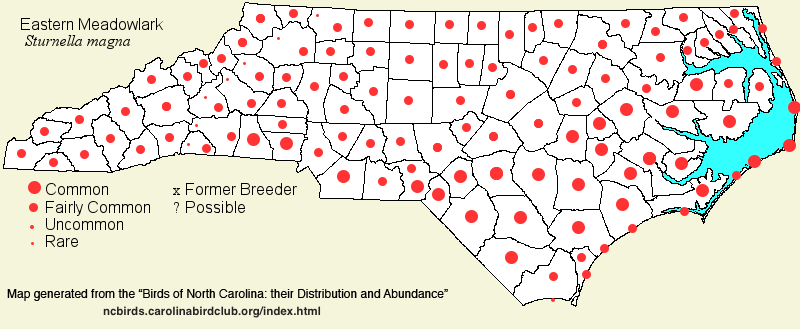 |  |
|
Eastern Meadowlark - Sturnella magna ICTERIDAE Members: | Search Common: Search Scientific: |
|
|
|||||||
| General Comments | The Eastern Meadowlark is the classic grassland bird of the eastern United States. As with nearly all grassland birds on the continent, it has suffered strong declines in numbers, though where suitable pastures are present, it is still common. It is somewhat migratory, but it is found in all North Carolina counties during the year, as a breeder and in winter (though scarce in the mountains at that season). In all seasons, it is a bird of pastures and meadows, without or essentially with no woody seedlings/saplings. It will feed on lawns and in harvested croplands with little cover, but it spends most of its time in grasses from 5-12 inches high. | ||||||
| Breeding Status | Breeder | ||||||
| NC BRC List | Definitive | ||||||
| State Status | |||||||
| U.S. Status | |||||||
| State Rank | S4B,S4N | ||||||
| Global Rank | G5 | ||||||
| Coastal Plain | Permanent resident, with migratory movements; somewhat declining. Generally common across the region, in all seasons, where there is suitable habitat. Slightly more numerous in winter than in summer. Peak counts: | ||||||
| Piedmont | Permanent resident, with migratory movements; declining. Generally fairly common to locally common across the region, in all seasons, where there is suitable habitat. Formerly common and more widespread prior to about 1980. Peak counts: | ||||||
| Mountains | Permanent resident, with migratory movements; somewhat declining. In summer, generally fairly common (formerly common) at low to middle elevations, up to about 3,500 feet; uncommon to perhaps 4,000 feet. Casual at high elevations (even over 6,000 feet) in migration. Much less numerous in winter, when generally uncommon (at best) in the lower elevations (below 2,500 feet), and rare higher. Peak counts: | ||||||
| Finding Tips |
None needed when suitable habitat is found, though it may take a while to find suitable pastures and short-grass fields, which are declining by the year. **** | ||||||
| Attribution | LeGrand[2023-04-02], LeGrand[2012-11-08], LeGrand[2011-12-19] | ||||||
| NC Map Map depicts all counties with a report (transient or resident) for the species. | Click on county for list of all known species. |
| NC Breeding Season Map Map depicts assumed breeding season abundance for the species. |  |